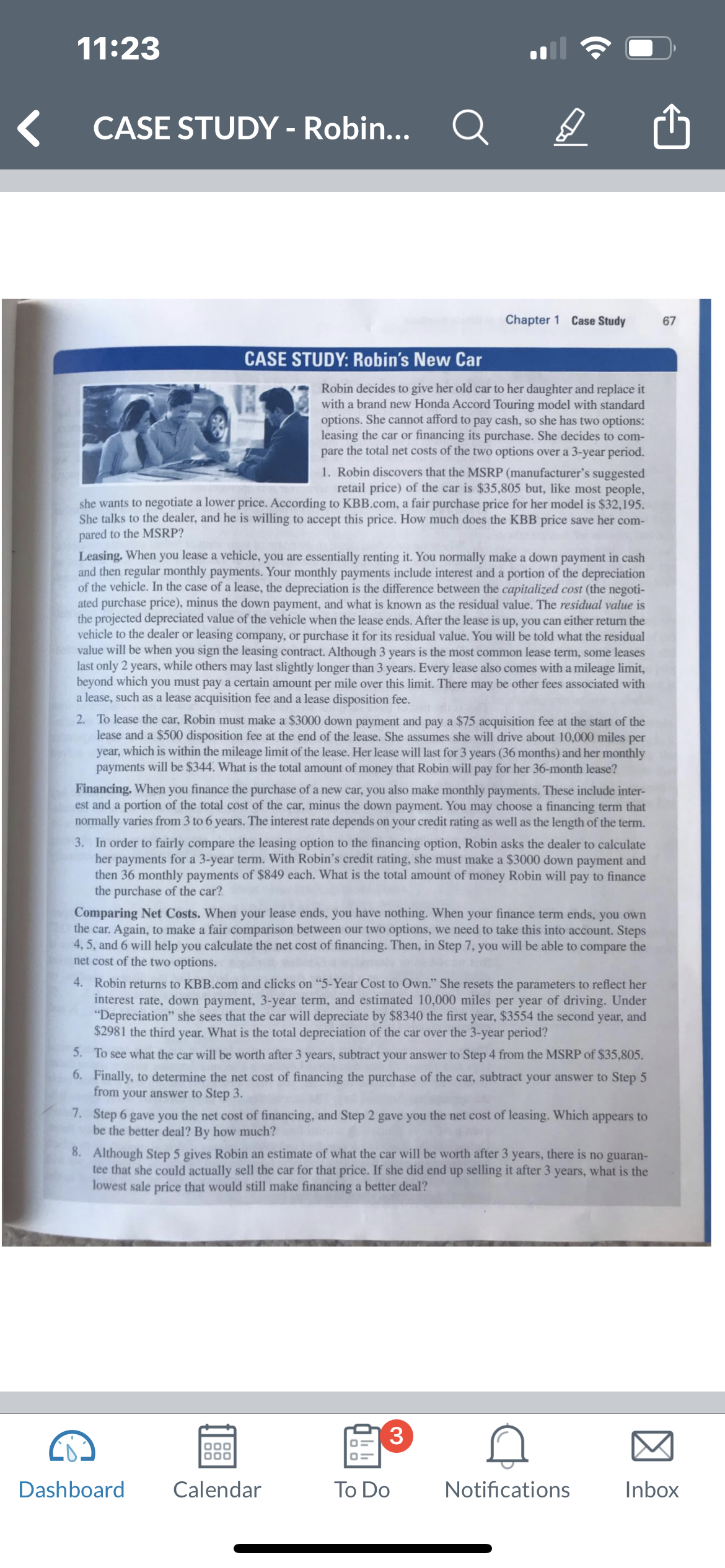Answered step by step
Verified Expert Solution
Question
1 Approved Answer
Questions 1-8 Please!! CASE STUDY: Robin's New Car Robin decides to give her old car to her daughter and replace it with a brand new

Questions 1-8 Please!!
CASE STUDY: Robin's New Car Robin decides to give her old car to her daughter and replace it with a brand new Honda Accord Touring model with standard options. She cannot afford to pay cash, so she has two options: leasing the car or financing its purchase. She decides to compare the total net costs of the two options over a 3-year period. 1. Robin discovers that the MSRP (manufacturer's suggested retail price) of the car is $35,805 but, like most people, she wants to negotiate a lower price. According to KBB.com, a fair purchase price for her model is $32,195. She talks to the dealer, and he is willing to accept this price. How much does the KBB price save her compared to the MSRP? Leasing. When you lease a vehicle, you are essentially renting it. You normally make a down payment in cash and then regular monthly payments. Your monthly payments include interest and a portion of the depreciation of the vehicle. In the case of a lease, the depreciation is the difference between the capitalized cost (the negotiated purchase price), minus the down payment, and what is known as the residual value. The residual value is the projected depreciated value of the vehicle when the lease ends. After the lease is up, you can either return the vehicle to the dealer or leasing company, or purchase it for its residual value. You will be told what the residual value will be when you sign the leasing contract. Although 3 years is the most common lease term, some leases last only 2 years, while others may last slightly longer than 3 years. Every lease also comes with a mileage limit, beyond which you must pay a certain amount per mile over this limit. There may be other fees associated with a lease, such as a lease acquisition fee and a lease disposition fee. 2. To lease the car, Robin must make a $3000 down payment and pay a $75 acquisition fee at the start of the lease and a $500 disposition fee at the end of the lease. She assumes she will drive about 10,000 miles per year, which is within the mileage limit of the lease. Her lease will last for 3 years ( 36 months) and her monthly payments will be $344. What is the total amount of money that Robin will pay for her 36-month lease? Financing. When you finance the purchase of a new car, you also make monthly payments. These include interest and a portion of the total cost of the car, minus the down payment. You may choose a financing term that normally varies from 3 to 6 years. The interest rate depends on your credit rating as well as the length of the term. 3. In order to fairly compare the leasing option to the financing option, Robin asks the dealer to calculate her payments for a 3-year term. With Robin's credit rating, she must make a $3000 down payment and then 36 monthly payments of $849 each. What is the total amount of money Robin will pay to finance the purchase of the car? Comparing Net Costs. When your lease ends, you have nothing. When your finance term ends, you own the car. Again, to make a fair comparison between our two options, we need to take this into account. Steps 4,5 , and 6 will help you calculate the net cost of financing. Then, in Step 7, you will be able to compare the net cost of the two options. 4. Robin returns to KBB.com and clicks on "5-Year Cost to Own." She resets the parameters to reflect her interest rate, down payment, 3-year term, and estimated 10,000 miles per year of driving. Under "Depreciation" she sees that the car will depreciate by $8340 the first year, $3554 the second year, and $2981 the third year. What is the total depreciation of the car over the 3-year period? 5. To see what the car will be worth after 3 years, subtract your answer to Step 4 from the MSRP of $35,805. 6. Finally, to determine the net cost of financing the purchase of the car, subtract your answer to Step 5 from your answer to Step 3. 7. Step 6 gave you the net cost of financing, and Step 2 gave you the net cost of leasing. Which appears to be the better deal? By how much? 8. Although Step 5 gives Robin an estimate of what the car will be worth after 3 years, there is no guarantee that she could actually sell the car for that price. If she did end up selling it after 3 years, what is the lowest sale price that would still make financing a better deal? CASE STUDY: Robin's New Car Robin decides to give her old car to her daughter and replace it with a brand new Honda Accord Touring model with standard options. She cannot afford to pay cash, so she has two options: leasing the car or financing its purchase. She decides to compare the total net costs of the two options over a 3-year period. 1. Robin discovers that the MSRP (manufacturer's suggested retail price) of the car is $35,805 but, like most people, she wants to negotiate a lower price. According to KBB.com, a fair purchase price for her model is $32,195. She talks to the dealer, and he is willing to accept this price. How much does the KBB price save her compared to the MSRP? Leasing. When you lease a vehicle, you are essentially renting it. You normally make a down payment in cash and then regular monthly payments. Your monthly payments include interest and a portion of the depreciation of the vehicle. In the case of a lease, the depreciation is the difference between the capitalized cost (the negotiated purchase price), minus the down payment, and what is known as the residual value. The residual value is the projected depreciated value of the vehicle when the lease ends. After the lease is up, you can either return the vehicle to the dealer or leasing company, or purchase it for its residual value. You will be told what the residual value will be when you sign the leasing contract. Although 3 years is the most common lease term, some leases last only 2 years, while others may last slightly longer than 3 years. Every lease also comes with a mileage limit, beyond which you must pay a certain amount per mile over this limit. There may be other fees associated with a lease, such as a lease acquisition fee and a lease disposition fee. 2. To lease the car, Robin must make a $3000 down payment and pay a $75 acquisition fee at the start of the lease and a $500 disposition fee at the end of the lease. She assumes she will drive about 10,000 miles per year, which is within the mileage limit of the lease. Her lease will last for 3 years ( 36 months) and her monthly payments will be $344. What is the total amount of money that Robin will pay for her 36-month lease? Financing. When you finance the purchase of a new car, you also make monthly payments. These include interest and a portion of the total cost of the car, minus the down payment. You may choose a financing term that normally varies from 3 to 6 years. The interest rate depends on your credit rating as well as the length of the term. 3. In order to fairly compare the leasing option to the financing option, Robin asks the dealer to calculate her payments for a 3-year term. With Robin's credit rating, she must make a $3000 down payment and then 36 monthly payments of $849 each. What is the total amount of money Robin will pay to finance the purchase of the car? Comparing Net Costs. When your lease ends, you have nothing. When your finance term ends, you own the car. Again, to make a fair comparison between our two options, we need to take this into account. Steps 4,5 , and 6 will help you calculate the net cost of financing. Then, in Step 7, you will be able to compare the net cost of the two options. 4. Robin returns to KBB.com and clicks on "5-Year Cost to Own." She resets the parameters to reflect her interest rate, down payment, 3-year term, and estimated 10,000 miles per year of driving. Under "Depreciation" she sees that the car will depreciate by $8340 the first year, $3554 the second year, and $2981 the third year. What is the total depreciation of the car over the 3-year period? 5. To see what the car will be worth after 3 years, subtract your answer to Step 4 from the MSRP of $35,805. 6. Finally, to determine the net cost of financing the purchase of the car, subtract your answer to Step 5 from your answer to Step 3. 7. Step 6 gave you the net cost of financing, and Step 2 gave you the net cost of leasing. Which appears to be the better deal? By how much? 8. Although Step 5 gives Robin an estimate of what the car will be worth after 3 years, there is no guarantee that she could actually sell the car for that price. If she did end up selling it after 3 years, what is the lowest sale price that would still make financing a better dealStep by Step Solution
There are 3 Steps involved in it
Step: 1

Get Instant Access to Expert-Tailored Solutions
See step-by-step solutions with expert insights and AI powered tools for academic success
Step: 2

Step: 3

Ace Your Homework with AI
Get the answers you need in no time with our AI-driven, step-by-step assistance
Get Started


